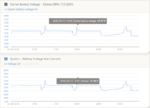in h
Free Member
- Messages
- 789
A b2b will charge both sets of batteries separately, allowing for their different capacity, different state of charge, different type.So the question is, what is the advantage or not of B2B over this VSR setup (see picture) that I found on
A VSR joins them together whenever the voltage rises enough to suggest that there is some charging going on.
B2B is far better and will get the best from your batteries, both in terms of capacity and in longevity. Costs £100 to £500.
A VSR is cheaper. Usually about £20 to £30.
A SCR is far cheaper again, and works slightly better than a VSR, but needs one more (thin) wire connection. Costs 99p to £10.
Your choice. There's no right or wrong answer.

